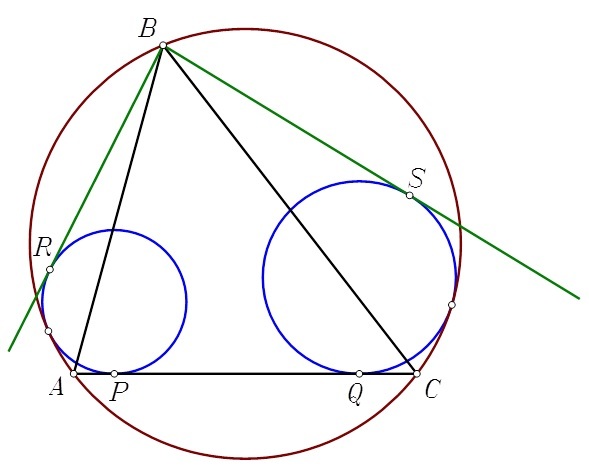A lot of tangency points
The triangle A B C is inscribed in the circle C . Circle C 1 is tangent to the minor arc A B of C and to side A C at point P . Circle C 2 is tangent to the minor arc C B of C and to side A C at point Q . From point B draw the tangents B R and B S to circles C 1 and C 2 , respectively. It is known that B A = 2 2 , B C = 2 3 , B R = 1 6 , B S = 1 7 , P Q = 1 5 . A C can be written as b a , where a and b are coprime positive integers. What is the value of a + b ?

The answer is 236.
This section requires Javascript.
You are seeing this because something didn't load right. We suggest you, (a) try
refreshing the page, (b) enabling javascript if it is disabled on your browser and,
finally, (c)
loading the
non-javascript version of this page
. We're sorry about the hassle.
1 solution
" Sorry for the bad latex, but i didn't manage to format the text well."
Are you sure that the circles C 1 and C 2 dont intersect with each other? Because if they intersect, then Casey's theorem is not valid.
Log in to reply
We could use Casey's theorem on A , B , C and C 1 .Here we are sure that A , B , C don't belong to C 1 . We obtain, calling A P x and C Q y : B C ⋅ A P + ( x + y + 1 5 ) ⋅ B R = A B ⋅ ( 1 5 + y ) → 2 3 x + 1 6 x + 1 6 y + 1 6 ⋅ 1 5 = 2 2 ⋅ 1 5 + 2 2 y → 3 9 x − 6 y = 9 0 . Using Casey's theorem on A , B , C and C 2 , we obtain B S ⋅ ( x + y + 1 5 ) + y ⋅ A B = B C ⋅ ( x + 1 5 ) → 1 7 x + 1 7 y + 1 7 ⋅ 1 5 + 2 2 y = 2 3 x + 2 3 ⋅ 1 5 → 3 9 y − 6 x = 9 0 . Solving the sistem we obtain the same results i have told before. Is that correct (thank you for the observations) ?
Log in to reply
Yeah.. Anyways they have drawn the figure now! :)
We use Casey' s theorem. We denote with T(a,b) the length of the tangency segment between A and B. First we consider the 4 circles C2, A (degenerate circle), C1 and B(degenerate circle). We have T(C2,A)xT(C1,B)+T(A,C1)xT(B,C2)=T(C2,C1)xT(A,B). So we have AQxBR+APxBS=PQxAB, which is equal to (AP+PQ)x16+APx17=15x22 ---> (AP+15)x16+APx17=15x22 --->33xAP=15x6 ---> AP=30/11. Then we consider the 4 circles C2, C (degenerate circle), C1 and B(degenerate circle). We have T(C2,C)xT(C1,B)+T(C,C1)xT(B,C2)=T(C2,C1)xT(C,B). So we have CQxBR+CPxBS=PQxCB, which is equal to CQx16+(CQ+QP)x17=15x23 ---> CQx16+(CQ+15)x17=15x23 --->33xCQ=15x6 ---> CQ=30/11. So we have AC=AP+PQ+CQ=225/11, so a+b=236. Sorry for the bad latex, but i didn't manage to format the text well.